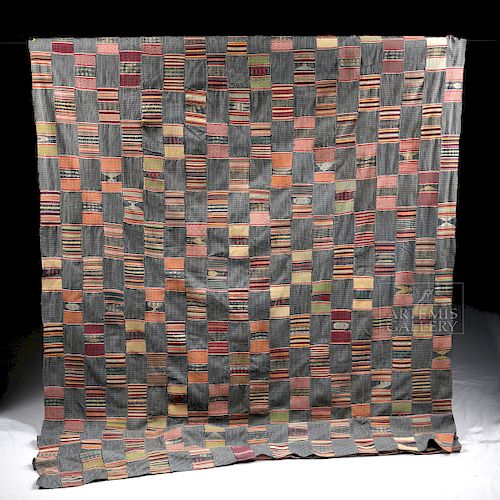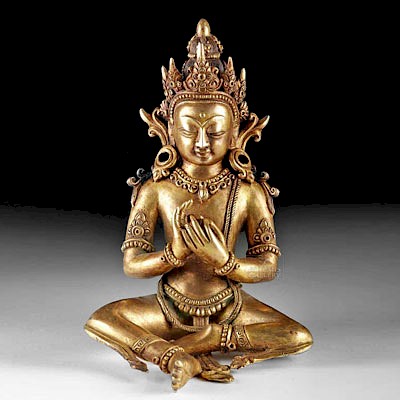African Ewe Kente Textile Wrap - ca. 1960
Lot 113a
About Seller
Artemis Fine Arts
686 S Taylor Ave, Ste 106
Louisville, CO 80027
United States
Selling antiquities, ancient and ethnographic art online since 1993, Artemis Gallery specializes in Classical Antiquities (Egyptian, Greek, Roman, Near Eastern), Asian, Pre-Columbian, African / Tribal / Oceanographic art. Our extensive inventory includes pottery, stone, metal, wood, glass and textil...Read more
Estimate:
$3,000 - $5,000
Absentee vs Live bid
Two ways to bid:
- Leave a max absentee bid and the platform will bid on your behalf up to your maximum bid during the live auction.
- Bid live during the auction and your bids will be submitted real-time to the auctioneer.
Bid Increments
| Price | Bid Increment |
|---|---|
| $0 | $25 |
| $300 | $50 |
| $1,000 | $100 |
| $2,000 | $250 |
| $5,000 | $500 |
| $10,000 | $1,000 |
| $20,000 | $2,500 |
| $50,000 | $5,000 |
| $100,000 | $10,000 |
| $200,000 | $20,000 |
About Auction
By Artemis Fine Arts
Jun 6, 2019
Set Reminder
2019-06-06 10:00:00
2019-06-06 10:00:00
America/New_York
Bidsquare
Bidsquare : VARIETY AUCTION | Ancient & Ethnographic
https://www.bidsquare.com/auctions/artemis-gallery/variety-auction-ancient-ethnographic-4182
Around the world & back in time - be amazed at the treasures you will find. Antiquities from Egypt, Greece, Italy and the Near East, Asian, Pre-Columbian, African / Tribal / Oceanic, Native American, Spanish Colonial, Russian Icons, Fine Art, much more! All categories, all price ranges...all legal Artemis Fine Arts info@artemisfinearts.com
Around the world & back in time - be amazed at the treasures you will find. Antiquities from Egypt, Greece, Italy and the Near East, Asian, Pre-Columbian, African / Tribal / Oceanic, Native American, Spanish Colonial, Russian Icons, Fine Art, much more! All categories, all price ranges...all legal Artemis Fine Arts info@artemisfinearts.com
- Lot Description
Western Africa, Ghana, Ewe, ca. 1960. An outstanding Ewe Kente cloth, finely handwoven from cotton fibers of indigo blue, salmon pink, vermilion red, golden yellow, seafoam green, creamy beige, dove grey, black, and white - displaying a mesmerizing pattern comprised of countless striated, checkerboard, and fretted panels oriented in juxtaposed vertical and horizontal directions - some with additional whimsical motifs inspired by nature - perhaps fishtails, butterflies, and bird wings - that are stitched together to form this large, special Kente cloth. An exemplar of these highly prized textiles which are widely admired for the immense skill required to create them as well as their mesmerizing colors and stylings. Given the high demand for Ewe Kente cloths, it has become very challenging to find older cloths like this example. Kente cloth has a fascinating history (see below); it was originally reserved for elite Asante royalty and limited to ritualistic and special social occasions. Today, it is still associated with sophistication and those of elite social status. Size: 105" L x 60.5" W (266.7 cm x 153.7 cm)
Kente cloth was worn by those of the Asante Kingdom as well as the Ewe people under the reign of the Asante kingdom in the late 18th century. The Ewe adopted the kente style, only with a few differences. Although the cloths were still linked to those of an elite social class and for special occasions, they were not limited to royalty. In addition, there are a wide variety of patterns and purposes for Ewe kente cloths, and the symbolism of the motifs is associated with daily life rather than wealth and high social status.
For the Asante (Ashanti) people of Ghana, a beloved legend describes how two male friends —Ota Karaban and Kwaku Ameyaw—learned the art of weaving by observing a spider weaving a web. One particular night, when the pair was checking their animal traps in the forest, they were struck by this web's marvelous patterns sparkling in the moonlight. Ananse, as the spider was called, offered to teach the men how to weave these designs in exchange for several favors. The men in turn learned how to weave the designs with a single thread and returned home to Bonwire. Soon Asantehene Osei Tutu, first ruler of the Asante kingdom, learned of their discovery. Named kente, this creation was coveted as a royal cloth reserved for special occasions, and Bonwire became the leading kente weaving center for the asantehene and his court.
Provenance: private Poos collection, Overland Park, Kansas, USA - One of the largest privately held quilt and textile collections in the world, the Poos Collection has evolved over 50 years and through extensive travels to allow for original or point of source acquisition. The collection includes international textiles and garments with an emphasis on West African textiles such as adire, aso oke, kente, and ewe woven prestige cloths.
All items legal to buy/sell under U.S. Statute covering cultural patrimony Code 2600, CHAPTER 14, and are guaranteed to be as described or your money back.
A Certificate of Authenticity will accompany all winning bids.
We ship worldwide and handle all shipping in-house for your convenience.
#145213Some areas of separation to seams, a few small holes and stains commensurate with age an use. Otherwise in excellent condition.Condition
- Shipping Info
-
All shipping is handled in-house for your convenience. Your invoice from Artemis Gallery will include shipping calculation instructions. If in doubt, please inquire BEFORE bidding for estimated shipping costs for individual items.
-
- Buyer's Premium



 EUR
EUR CAD
CAD AUD
AUD GBP
GBP MXN
MXN HKD
HKD CNY
CNY MYR
MYR SEK
SEK SGD
SGD CHF
CHF THB
THB















